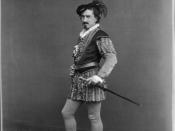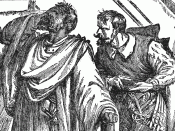In the Sixteenth century, as we can clearly see from Othello, blacks and women were not treated as equals with the rest of the society. White males were superior to all others. Women were considered second to men and then following that was the black race. Racism is a particularly important theme in the play; it has a great deal of influence on how people in the play regard Othello. Some Characters in the play distrust black people merely on their appearances. A good example of this is Iago. The fact that Othello is a black man in the play immediately categorized him and began making him a very self-conscious man, pushing him to work harder and be more concerned about his reputation. He wanted to regarded as an equal person with the rest of society. A good example that demonstrates racism through the characters is that Othello is referred to as the Moor fifty-eight times and his real name only seventeen times throughout the play.
There are three main female characters in the play. These characters are Desdemona, Bianca, and Emilia. Shakespear characterizes Desdemona as good hearted, courageous, innocent, and pure. Emilia is portrayed as a strong realist and Bianca is basically portrayed as a whore.
Throughout the play characters make several generalizations about the women and the Moor and their place as second citizens in society. In Act 1 Scene 1 Iago introduces the first few hints of his discrimination of women and his hatred for blacks. When Iago is talking to Roderigo he says to him, "A fellow almost damned in a fair wife"(I, i, 21) What Iago means by this is that if Cassio marries a woman, it will be the ruin of him, because all pretty women are false to their husbands. In...
![From the Library of Congress: TITLE: Thos. W. Keene. Othello CALL NUMBER: POS - TH - 1884 .O7, no. 1 (C size) [P&P] REPRODUCTION NUMBER: LC-USZC6-58 (color film copy transparency) RIGHTS INFORMATION: No known restrictions on publication. MEDIUM: 1 print (](https://s.writework.com/uploads/9/94760/library-congress-title-thos-w-keene-othello-call-number-pos-thumb.jpg)

